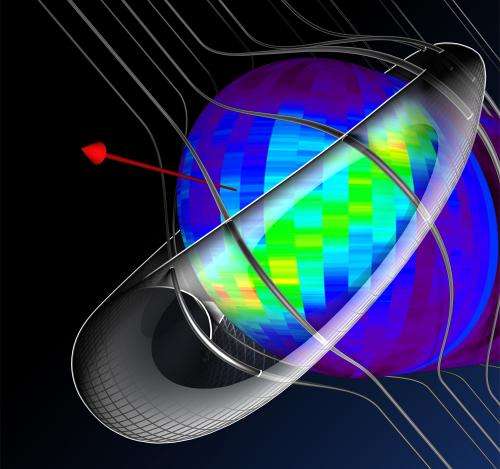Scientists reveal cosmic roadmap to galactic magnetic field

Scientists on NASA's Interstellar Boundary Explorer (IBEX) mission, including a team leader from the University of New Hampshire, report that recent, independent measurements have validated one of the mission's signature findings—a mysterious "ribbon" of energy and particles at the edge of our solar system that appears to be a directional "roadmap in the sky" of the local interstellar magnetic field.
Unknown until now, the direction of the galactic magnetic field may be a missing key to understanding how the heliosphere—the gigantic bubble that surrounds our solar system—is shaped by the interstellar magnetic field and how it thereby helps shield us from dangerous incoming galactic cosmic rays. "Using measurements of ultra-high energy cosmic rays on a global scale, we now have a completely different means of verifying that the field directions we derived from IBEX are consistent," says Nathan Schwadron, lead scientist for the IBEX Science Operations Center at the UNH Institute for the Study of Earth, Oceans, and Space. Schwadron and IBEX colleagues published their findings online today in Science Express.
Establishing a consistent local interstellar magnetic field direction using IBEX low-energy neutral atoms and galactic cosmic rays at ten orders of magnitude higher energy levels has wide-ranging implications for the structure of our heliosphere and is an important measurement to be making in tandem with the Voyager 1 spacecraft, which is in the process of passing beyond our heliosphere.
"The cosmic ray data we used represent some of the highest energy radiation we can observe and are at the opposite end of the energy range compared to IBEX's measurements," says Schwadron. "That it's revealing a consistent picture of our neighborhood in the galaxy with what IBEX has revealed gives us vastly more confidence that what we're learning is correct."
How magnetic fields of galaxies order and direct galactic cosmic rays is a crucial component to understanding the environment of our galaxy, which in turn influences the environment of our entire solar system and our own environment here on Earth, including how that played into the evolution of life on our planet.
Notes David McComas, principal investigator of the IBEX mission at Southwest Research Institute and coauthor on the Science Express paper, "We are discovering how the interstellar magnetic field shapes, deforms, and transforms our entire heliosphere."

To date, the only other direct information gathered from the heart of this complex boundary region is from NASA's Voyager satellites. Voyager 1 entered the heliospheric boundary region in 2004, passing beyond what's known as the termination shock where the solar wind abruptly slows. Voyager 1 is believed to have crossed into interstellar space in 2012.
Interestingly, when scientists compared the IBEX and cosmic ray data with Voyager 1's measurements, the Voyager 1 data provide a different direction for the magnetic fields just outside our heliosphere.
That's a puzzle but it doesn't necessarily mean one set of data is wrong and one is right. Voyager 1 is taking measurements directly, gathering data at a specific time and place, while IBEX gathers information averaged over great distances—so there is room for discrepancy. Indeed, the very discrepancy can be used as a clue: understand why there's a difference between the two measurements and gain new insight.
"It's a fascinating time," says Schwadron. "Fifty years ago, we were making the first measurements of the solar wind and understanding the nature of what was just beyond near-Earth space. Now, a whole new realm of science is opening up as we try to understand the physics all the way outside the heliosphere."
Eberhard Möbius, UNH principal scientist for the IBEX-Lo instrument on board, is a coauthor on the Science Express paper along with colleagues from institutions around the country.
IBEX is a NASA Heliophysics Small Explorer mission. The Southwest Research Institute in San Antonio, Texas, leads IBEX with teams of national and international partners. NASA's Goddard Space Flight Center in Greenbelt, Md., manages the Explorers Program for the agency's Science Mission Directorate in Washington.
More information: "Global Anisotropies in TeV Cosmic Rays Related to the Sun's Local Galactic Environment from IBEX," by N.A. Schwadron et al. Science, 2014. www.sciencemag.org/content/ear … 2/12/science.1245026
Journal information: Science Express , Science
Provided by University of New Hampshire




















